
IAMC INSIDER
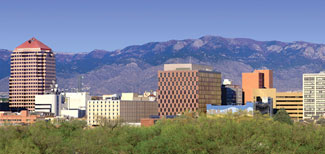
U.S. News and World Report has ranked Albuquerque among the "Top Ten Places to Live 2009." General Mills, an Albuquerque fixture since 1991, is one of many companies finding the city to their liking for locations and expansions.
Photo courtesy of Albuquerque Convention and
Visitors Bureau and MarbleStreetStudio.com
Visitors Bureau and MarbleStreetStudio.com
E
ven as it divests itself of facilities in other places, IAMC corporate member firm General Mills is growing in the growing city of Albuquerque, where this spring it broke ground on a $100-million, 176,000-sq.-ft. (16,350-sq.-m.) expansion of its cereal manufacturing plant. The project, which will add 60 jobs, will bring the total payroll to $15.5 million, spread among 250 employees. A $100-million industrial revenue bond deal related to the project was approved by the Albuquerque City Council in February. Among the amenities at the existing 275,000-sq.-ft. (25,548-sq.-m.) General Mills complex, which makes 35 different products, is a lab that assists the company in developing instructions for baking its products at high altitudes. Gary Tonjes, president of Albuquerque Economic Development, is an IAMC member.
I
ndiana-based IAMC corporate member organization Cummins Inc. in April named a fellow IAMC member firm, Chicago, Ill.-based Colliers Bennett & Kahnweiler Inc., its global real estate services provider, an assignment that includes transaction management, portfolio administration, and lease administration for a multi-million-sq.-ft. portfolio. Alain G. LeCoque, executive vice president of Colliers B&K, will lead the global account team. "The Colliers team very effectively demonstrated the strength of its worldwide capabilities and we have every confidence that our financial and operating goals will be achieved as a result of this relationship," said IAMC member Todd Clark, global real estate director of Cummins Inc. "A number of factors, including Colliers' experience managing large portfolios and our cultural similarities, all contributed to our selection. It is more important now than ever to maximize the efficiency and value of our real estate, and we are pleased to have Colliers as a partner in this endeavor."

I
n early June, Nestlé Waters North America displayed at the "Hybrid on the Hill" event in Washington, D.C., one of the four diesel-electric hybrid (DEH) delivery trucks (right) the company's Home & Office division has operated since November 2008. The DEH vehicles are expected to deliver a 25-percent improvement in fuel economy, and the company plans to deploy eight more by the end of this summer.
That same week in June, the company's Nestlé Pure Life water bottling facility
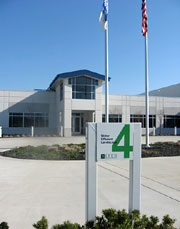
The company has led the way in its sector, now counting more than 2.5 million sq. ft. (232,250 sq. m.) designed and built to meet LEED standards.
The Breinigsville facility's design will save 9.9 million BTUs of energy conserve 220,000 gallons of water each year – 55 percent better than the EPA requirement. It joins five other U.S. facilities with LEED certification, with three more currently under LEED review.
In the meantime, the company's search for a bottling operation site in the Pacific Northwest now includes a proposal for a 100-million-gallon-a-year plant in Cascade Locks, Ore.
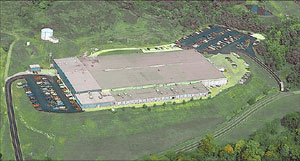
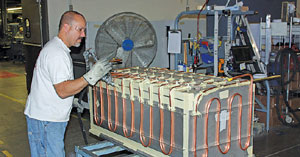
Profitability, safety and teamwork helped Thermo Fisher's plant in Marietta earn IndustryWeek's Best Plant award for 2008.
ThermoFisher Scientific
Earns 'Best Plant' Award
Earns 'Best Plant' Award
O
ne of 10 facilities in the United States singled out by Industry Week magazine as a winner of the coveted 2008 Best Plant award is the 130,300-sq.-ft. (12,105-sq.-m.) ThermoFisher Scientific Inc. manufacturing plant in Marietta, Ohio. The plant employs 458 in the manufacture of a range of laboratory equipment, including ultra-low-temperature freezers, cell culture incubators and other equipment used primarily for life sciences research.
In Marietta, the Pittsburgh-based company's Practical Process Improvement program led to projects that created approximately $2 million in savings in 2007 by reducing waste and improving efficiencies, helping the 59-year-old plant produce $4 million more in product than it did in 2006, with $100,000 less in labor costs.
G
EM Inc., a mechanical and electrical specialty contractor and subsidiary of IAMC member firm Rudolph/Libbe Companies, has purchased BHP Energy Solutions Ltd. of Hudson, Ohio, in order to provide customers with turnkey solutions for clean, energy-saving on-site power generation.
BHP is an authorized distributor of Capstone MicroTurbine power generation systems. Capstone MicroTurbines are compact, affordable energy systems that reduce energy costs while helping to protect the environment with near-zero emissions.
M
ember firm Norfolk Southern, already well down the road with its Heartland Corridor program to rejuvenate railborne distribution with new intermodal hubs and improved bridges and tunnels from the Northeast to the Midwest, now aims to do the same along what it's calling the Crescent Corridor, a 2,500-mile (4,023-km.) stretch of tracks from the Northeast through the Southeast to Louisiana. According to published reports, the railroad continues to work with officials in Birmingham, Ala., on siting a major intermodal facility in the area. According to a Birmingham News interview with IAMC member Ted VonCannon, president of Birmingham's Metropolitan Development Board, his organization has been working with the railroad for three years to find a good site for the project, and Norfolk Southern has evaluated half a dozen sites.

Map courtesy of Norfolk Southern
Norfolk Southern in April said it had participated in the location of 80 new industries and the expansion of 35 existing industries along its rail lines throughout 2008. New plants and expansions represented an investment of more than $2.2 billion by Norfolk Southern customers and are expected to create 3,623 jobs in the railroad's territory and eventually generate more than 136,000 carloads of new rail traffic annually.
"Renewable energy projects led the way across our service area in 2008," said Newell Baker, assistant vice president industrial development and one of five IAMC members from the railroad. "Our group was able to assist in the location of 19 ethanol and bio-diesel production and distribution facilities across 10 states. In addition, we completed eight projects with stone producers and electric utilities to facilitate rail shipment of high-calcium limestone for use in 'scrubbing' power plant air emissions to reduce atmospheric sulfur dioxide and meet future clean air standards."

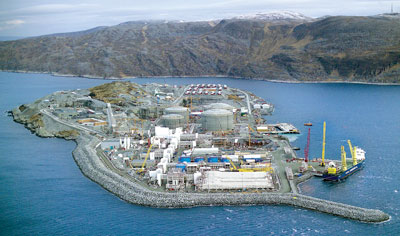
CBRE will be the exclusive global strategic real estate advisor for Nokia, whose headquarters in Espoo, Finland, is shown here (inset). CBRE also will advise on transaction and project management for Norway's StatoilHydro, whose range of operations includes properties such as the Snohvit LNG Export Terminal, Melkoya Island, Hammerfest, Norway. The US$5.3-billion project was completed in 2006 by a consortium led by StatoilHydro. A major engineering, construction and procurement contract for the project was awarded to IAMC member firm Linde, and liquefaction technology came from fellow IAMC member firm Air Products.
Photos courtesy of Nokia and Eilev Leren/StatoilHydro
The Nordic Connection
Within the span of one week this spring, IAMC member organization CB Richard Ellis secured two major global contracts in Scandinavia. First came its selection by Finland-based Nokia as the company's exclusive global strategic real estate advisor, covering transaction management, brokerage and lease administration for a 20 million-sq.-ft. (1.86-million-sq.-m.) global portfolio encompassing over 380 properties in 60 countries across Europe, the Middle East, Africa, Asia and the Americas.
Four days later, CBRE announced that Norway's StatoilHydro ASA had selected the firm as its preferred global real estate provider of transaction and project management services. StatoilHydro's 6-million-sq.-ft. (557,400-sq.-m.) global portfolio consists of over 70 properties in 40 countries.
